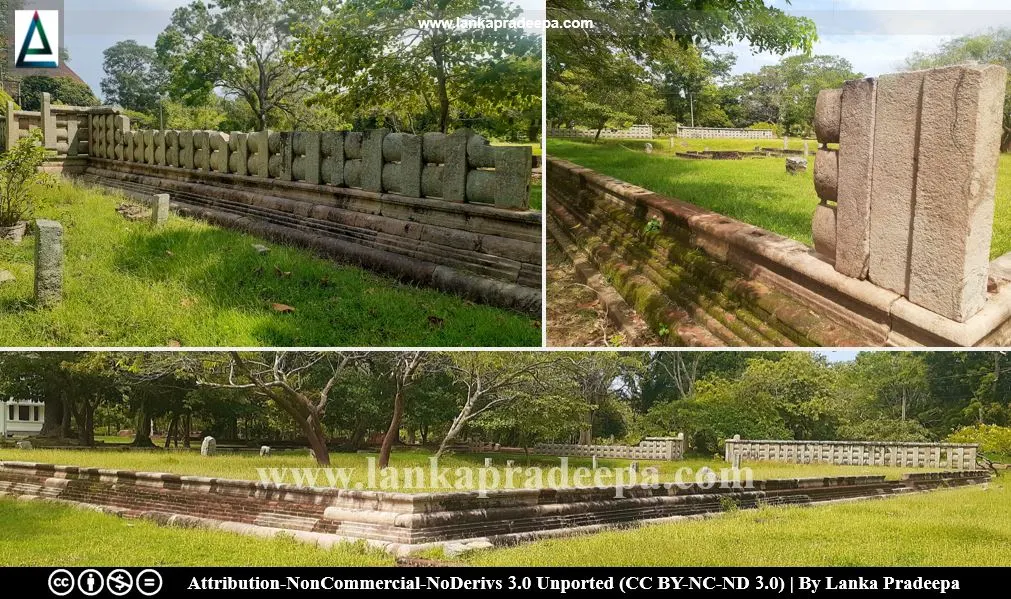
Buddhist Railing (Sinhala: ජේතවනාරාම බෞද්ධ ගරාදි වැට) is a ruined building associated with a stone fence located in the ancient monastery premises of Jetavanaramaya in Anuradhapura District, Sri Lanka. It lies near the backyard of the Jetavanarama Museum.
History
The period or the builder of this structure is not known. Some scholars identify this as an image house while others as a Bodhighara [(Bodhi tree shrine) Jayasuriya, 2016]. According to Mahavamsa, there had been a Bodhighara in Jetevanarama monastery during the periods of King Aggabodhi II (608-618 A.D.) and King Dappula II (815-831 A.D.). Dappula II is said to have presented a gold Buddha image to that shrine (Nicholas, 1963; Wikramagamage, 2004).
The building
This is a rectangular building of about 43 m long and 34 m wide and enclosed by a 1.6 m high stone fence known as the "Buddhist Railing". It has four entrances (one at the centre of each side) oriented to the four cardinal points. There are a few pillars at one entrance with sculptures of the Kalpawruksha [(wish-bestowing tree) Wikramagamage, 2004]. Inside the enclosed area are the rows of columns that carried the superstructure (Jayasuriya, 2016).
An image house or a Bodhighara?
The true identity of this building remains unsolved. The presence of stone seats, pedestals, fragments of images and their resemblance to the Gandhakuti type construction has led some scholars to believe that this is an image house. However, the existence of a square pit and a watercourse leading to it has tended others to think that it was a Bodhighara where a Bodhi tree had been planted (Wikramagamage, 2004). Probably this building may have been used in turn as an image house and a Bodhighara.
Buddhist railing fragmentary slab inscription
The upper part of an inscribed slab has been discovered at this site as recorded in the Annual Report of the A.S.C. for the year 1892 (Paranavitana, 1933; Ranawella, 2004). The record, written in the Sinhala language and scripts of the 10th century, contains certain regulations concerning the maintenance of a Gateway Water Pavilion that was built by some lay devotees attached to Ratnama Pirivena of the Jetavana monastery (Paranavitana, 1933; Ranawella, 2004). It is dated in the 7th regnal year of a king styled Sirisangbo Mihind who has been identified by scholars as King Mahinda IV [(956-972 A.D.) Paranavitana, 1933; Ranawella, 2004].
 .
.
References
1) Jayasuriya, E., 2016. A guide to the Cultural Triangle of Sri Lanka. Central Cultural Fund. ISBN: 978-955-613-312-7. pp.43-44.
2) Nicholas, C. W., 1963. Historical topography of ancient and medieval Ceylon. Journal of the Ceylon Branch of the Royal Asiatic
Society, New Series (Vol VI). Special Number: Colombo. Royal Asiatic
Society (Ceylon Branch). p.136.
3) Paranavitana, S., 1933. (Edited and translated by Wickremasinghe, D.M.D.Z.; Codrington, H.W.) A fragmentary slab inscription found at the Buddhist railing near Eastern Dagaba, Anuradhapura. Epigraphia Zeylanica: Being lithic and other inscriptions of Ceylon: Vol. III. Printed at the Department of Government Printing, Sri Lanka (Ceylon) for the Archeological Department. pp.226-229.
4) Ranawella, G.S., 2004. Inscription of Ceylon. Volume V, Part II. Department of Archaeology. ISBN: 955-9159-30-5. pp.239-241.
5) Wikramagamage, C., 2004. Heritage of Rajarata: Major natural, cultural,
and historic sites. Colombo. Central Bank of Sri Lanka. p.137.
Location Map
This page was last updated on 3 June 2022
For a complete tourist map follow this link: Lankapradeepa Tourist Map
For a complete tourist map follow this link: Lankapradeepa Tourist Map


